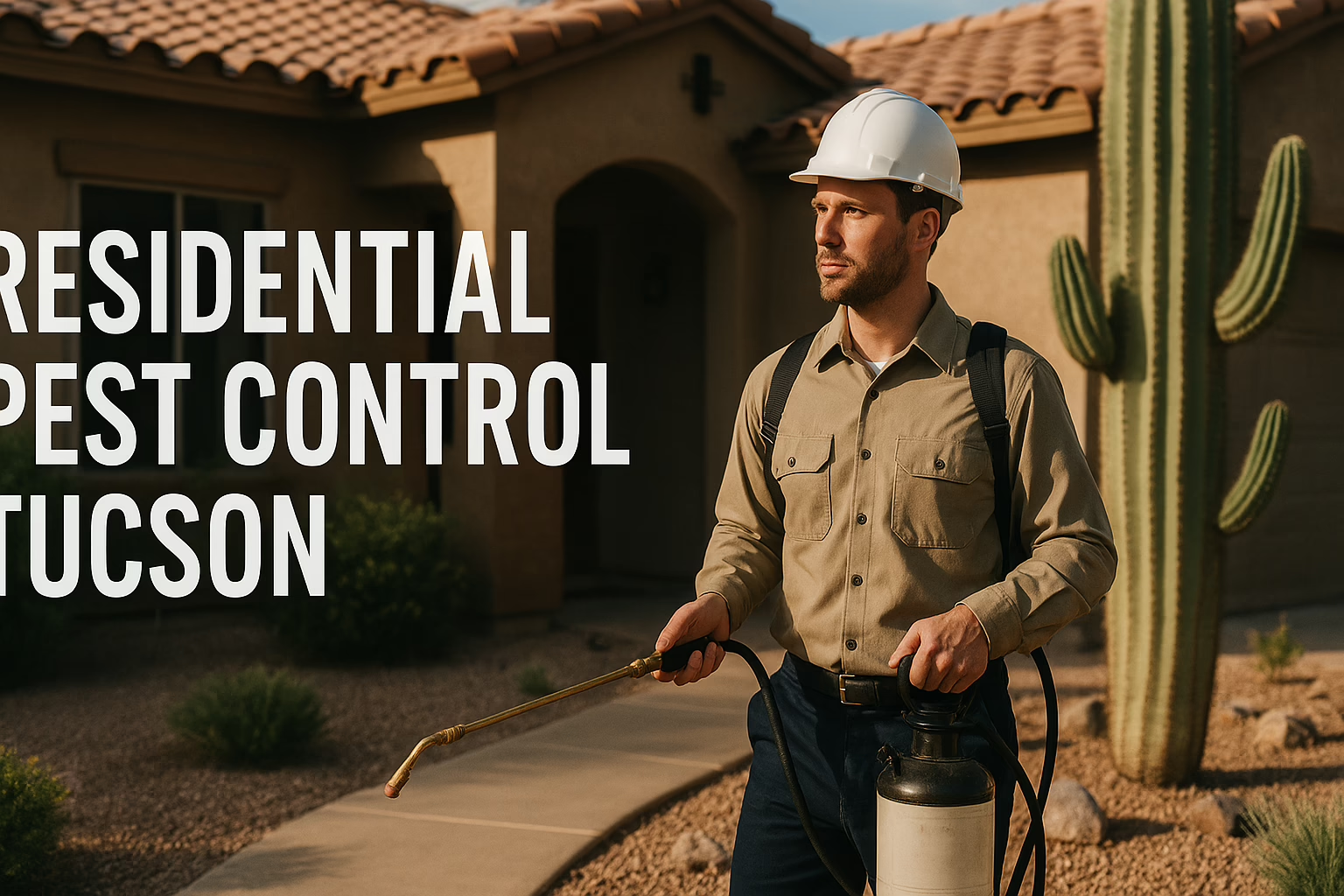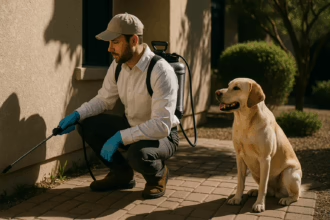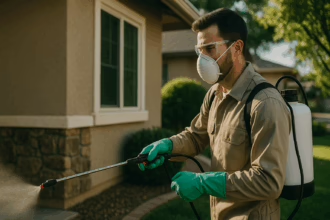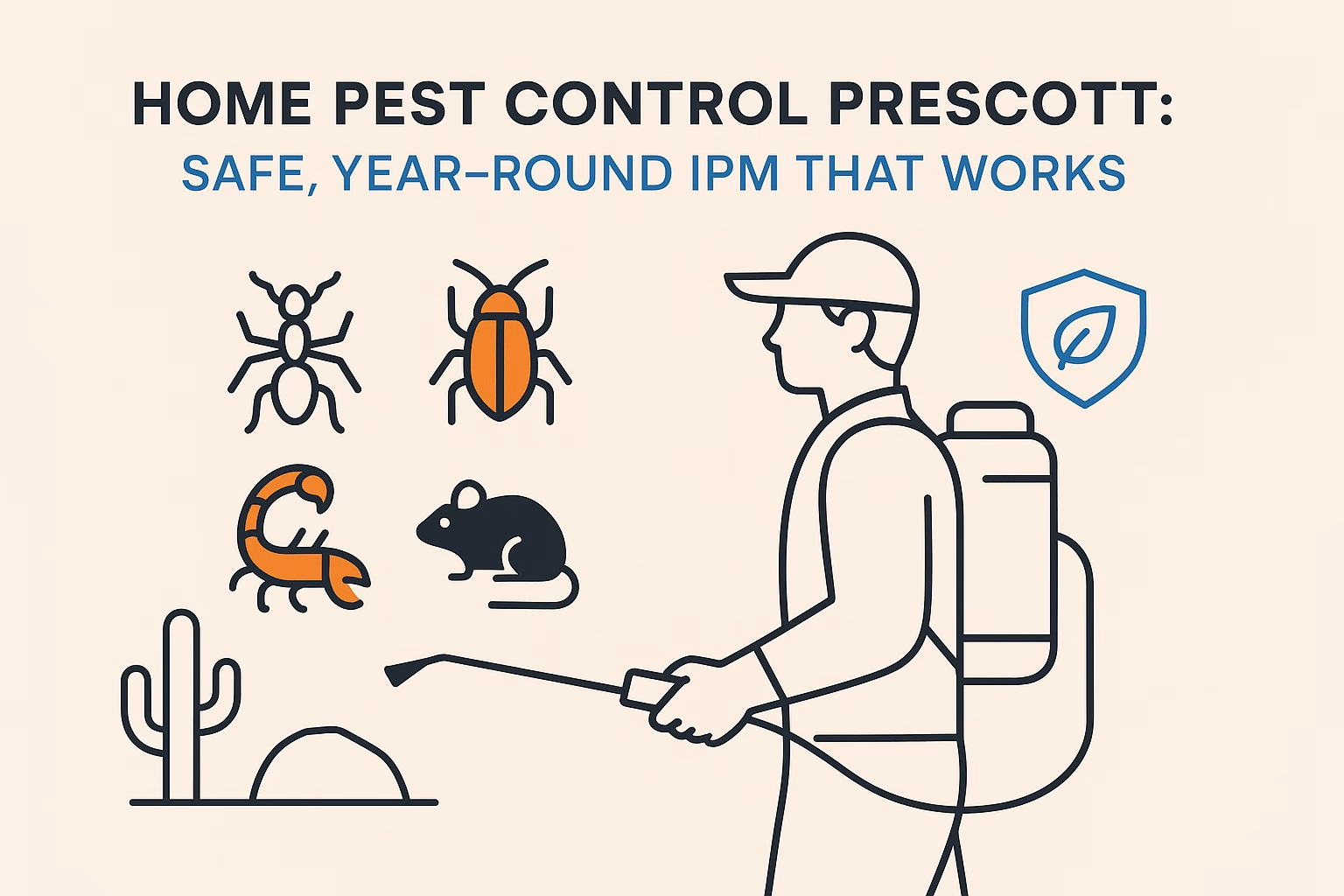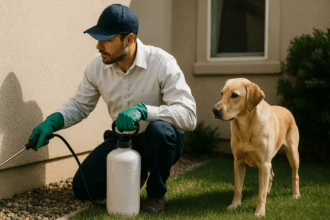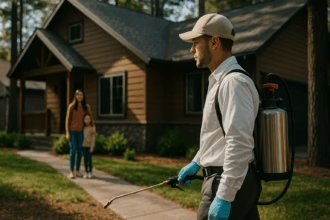Introduction
Desert living is beautiful—until scorpions, ants, and roaches move in
Tucson’s Sonoran Desert backdrop offers breathtaking sunsets, starry nights, and—unfortunately—prime conditions for pests. When daytime heat fades, scorpions, ants, roaches, and rodents become more active and look for cool, moist harborage inside your home. If you’ve noticed sudden bug surges after a monsoon or mystery crumbs disappearing from the pantry, you’re not alone.
The problem: Why Tucson homes face relentless seasonal pest pressure
Our region’s intense heat, dramatic monsoon season, and unique landscaping create shifting pest pressures all year. Many Tucson homes also feature block walls, tile roofs, and gravel yards—each providing microhabitats that attract pests and discreet entry points that are easy to miss.
Thesis: A strategic plan keeps pests out year‑round
Effective residential pest control Tucson solutions combine Integrated Pest Management (IPM), safety-first treatment choices, and local expertise. With a tailored approach from a home pest exterminator Tucson AZ, you can achieve affordable pest control Tucson that protects your family and property throughout every season.
Why Pests Thrive in Tucson Homes
Climate and seasons: Heat, monsoons, and microhabitats that attract pests
In Tucson, pests adapt quickly to weather cycles:
- Spring (pre-monsoon): Warming days jumpstart ant and termite activity. Scorpions emerge from winter harborage to hunt.
- Summer (monsoon): Moisture drives roaches and ants indoors, while standing water creates mosquito hot spots.
- Fall: Cooler nights send rodents and overwintering insects seeking warm structures.
- Winter: Rodents stay active; occasional invaders hide in garages, attics, and utility chases.
Landscapes with river rock, decomposed granite, and drip irrigation create cool, moist spaces under stones and along foundations—perfect for scorpions, roaches, ants, and earwigs.
Common entry points and attractants in Tucson construction and landscaping
- Block walls and weep holes: Tiny gaps along foundations and stucco cracks allow ants, scorpions, and roaches inside.
- Rooflines and tile gaps: Birds and rodents exploit openings at eaves and under barrel tiles; roaches climb up vines and conduits.
- Garage and door thresholds: Worn sweeps or settled slabs leave scorpion-sized openings.
- Irrigation and AC condensate: Persistent moisture attracts roaches, termites, and ants.
- Firewood, citrus, and debris piles: Harborage for rodents, scorpions, and spiders near structures.
The Pests Most Likely to Invade Tucson Residences
Biting and stinging threats: Scorpions, fire ants, wasps, and spiders
- Arizona bark scorpions: Nocturnal climbers that slip through hairline cracks; blacklight inspections reveal activity.
- Fire ants and harvester ants: Painful stings; mounds often appear after monsoon rains.
- Paper wasps and yellowjackets: Nest under eaves, patio furniture, playground equipment, and block walls.
- Spiders (including black widows): Prefer cluttered, undisturbed areas like garages, meter boxes, and patio corners.
Structural and property damage: Termites, carpenter ants, pack rats, and mice
- Subterranean termites: Common in Tucson; look for mud tubes, blistered paint, or soft baseboards. Annual inspections are essential.
- Carpenter ants: Excavation damage to moist wood around windows and rooflines; often mistaken for termites.
- Pack rats (woodrats): Build bulky nests in vegetation, grills, and engine bays; chew wiring and irrigation lines.
- House mice: Enter through gaps as small as a dime; contaminate food and trigger allergies.
Filth and nuisance pests: American/German cockroaches, pantry moths, and silverfish
- American cockroaches: Large “sewer roaches” move through drains and irrigation; frequent kitchens and bathrooms.
- German cockroaches: Thrive in warm kitchens; hitchhike in boxes and appliances; require precise, targeted control.
- Pantry moths and beetles: Infest flour, grains, pet food; often introduced via bulk goods.
- Silverfish: Favor humid bathrooms and storage areas; feed on paper, fabric, and starchy materials.
Occasional invaders and specialty concerns: Bed bugs, ticks, and kissing bugs
- Bed bugs: Travel with luggage and furniture; require thorough inspections and multi-method treatments.
- Ticks: Hide in shaded yards and pet resting spots; consistent yard maintenance and pet care are crucial.
- Kissing bugs (triatomines): Attracted to porch lights and pet bedding; seal structural gaps and use targeted exterior treatments.
How Residential Pest Control Works (IPM Focus)
Inspection and identification: Finding source conditions and harborages
An IPM-based residential pest control Tucson service starts with a detailed inspection. Technicians identify pest species, locate entry points and nests, and document conducive conditions such as moisture, clutter, and landscape harborage.
- Interior checks: Kitchens, baths, laundry rooms, garages, attics, and utility chases.
- Exterior checks: Eaves, block walls, weep holes, irrigation, foundation cracks, and vegetation contact.
- Tools: Monitors, inspection mirrors, UV lights (for scorpions), and moisture meters.
Customized treatment plan: Targeted, kid- and pet-safe solutions
Based on findings, your home pest exterminator Tucson AZ crafts a plan that prioritizes non-chemical tactics first and deploys targeted, regulated products only where necessary.
- Precision baits and gels in cracks/crevices for ants and roaches.
- Dusts in wall voids and attics for long-term protection.
- Exterior barrier treatments focused on foundation, eaves, and harborage zones.
- Rodent trapping/exclusion with tamper-resistant stations.
- Specialty protocols for scorpions, bed bugs, and German roaches.
Exclusion and habitat modification: Sealing, sanitation, and landscape best practices
- Seal: Door sweeps, weatherstripping, screen repair, sealing weep holes, and caulking stucco cracks.
- Fix moisture: Irrigation leaks, AC condensate drainage, and proper slope away from foundation.
- Landscape: Trim vegetation 12–18 inches from walls, create a dry gravel buffer, and elevate firewood/citrus storage.
- Sanitation: Tight-lid trash cans, stored food in sealed containers, and regular grease/crumb cleanup.
Follow-up and monitoring: Service cadence, thresholds, and documentation
IPM is continuous improvement. Expect periodic visits with bait replenishment, trap checks, and adjust-on-the-fly strategies based on monitoring data. You’ll receive clear documentation with photos, product lists, and recommendations.
 Online Only Pricing!
Online Only Pricing!
Tucson Pest Control—Fast, Local, Guaranteed
Book in minutes. Lock in our online-only rate and get priority scheduling.
- Stops ants, spiders, mice & pack rats
- No long-term contracts
- Family & pet-friendly options
- Money-back guarantee
Online takes ~60 seconds.
No gimmicks—just your price & schedule.
Prefer to talk? We can't guarantee our online prices over the phone.
We're happy to talk! Call us at (520) 476-0879
What to Expect from a Home Pest Exterminator Tucson AZ
The first visit: Detailed assessment, treatment mapping, and homeowner prep
- Interview about sightings, timelines, and pet/kid considerations.
- Full interior and exterior inspection with a written map of hotspots.
- Initial treatment prioritizing entry points, harborage areas, and high-activity zones.
- Homeowner prep list for best results (access, declutter, moisture fixes).
Service frequency: One-time, monthly, bi-monthly, and quarterly programs
Frequency depends on pest pressure, property risk, and preference:
- One-time: Good for minor, isolated issues; limited warranty.
- Monthly: Ideal for heavy roach, scorpion, or German roach pressure.
- Bi-monthly: Popular balance for most Tucson homes.
- Quarterly: Works for lower-pressure homes with strong exclusion.
Communication and transparency: Service reports, photos, and recommendations
Look for providers who deliver digital reports after every visit, including materials used, areas treated, photos of findings, and straightforward action items to prevent reinfestation.
Pricing and Value: Affordable Pest Control Tucson Without Cutting Corners
What influences cost: Home size, pest severity, products, and visit frequency
- Square footage, number of stories, and yard complexity.
- Pest type and severity (e.g., German roaches, scorpions, termites require specialized protocols).
- Product selection and specialty equipment (dusting, baiting, exclusion materials).
- Service cadence and warranty length.
Plans and savings: Bundles, seasonal specials, warranties, and reservice guarantees
- Bundle general pest with scorpion or rodent service for better value.
- Ask about pre-pay discounts, referral credits, and seasonal specials.
- Choose plans with clear reservice guarantees if pests return between scheduled visits.
When DIY costs more: Missed sources, reinfestations, and product misuse
- Over-the-counter sprays can repel pests deeper into walls, making issues worse.
- Misapplied products risk staining, odors, or off-target exposure.
- Unsealed entry points and untreated harborage areas cause expensive, repeated reinfestations.
Choosing the Right Tucson Provider
Credentials: Licensing, insurance, technician training, and local experience
- Arizona Department of Agriculture-licensed company and applicators.
- General liability and worker’s comp insurance.
- Ongoing training in IPM, desert pest biology, and product stewardship.
- Local track record with scorpions, termites, German roaches, and rodents.
Questions to ask your home pest exterminator Tucson AZ
- What’s included in your standard service versus specialty add-ons?
- How do you customize treatments for homes with kids and pets?
- What is your plan for scorpions or German roaches specifically?
- Do you provide photos and written reports after each visit?
- What warranties or reservice guarantees come with my plan?
Red flags to avoid: Vague scopes, no warranty, and aggressive contracts
- Unclear service descriptions or limits.
- No written warranty or reservice policy.
- High-pressure sales tactics or long, inflexible contracts.
- Reluctance to perform an inspection before quoting.
Tucson Seasonal Pest Calendar and Prevention Checklist
Spring (pre-monsoon): Ants, termites, and scorpion activity ramps up
- Install door sweeps and repair window screens.
- Schedule a termite inspection and address irrigation leaks.
- Reduce clutter in garages and storage to limit scorpion and spider harborage.
Summer (monsoon): Roach surges, mosquito hotspots, and landscape harborage
- Eliminate standing water in planters, gutters, and toys.
- Maintain a dry gravel buffer 12–24 inches around the foundation.
- Keep trash lids tight; clean bins and outdoor cooking areas frequently.
Fall: Overwintering pests and rodent intrusion prevention
- Seal utility penetrations and gaps under exterior doors.
- Trim trees and vines away from rooflines and block walls.
- Store pet food and bird seed in airtight containers.
Winter: Rodent vigilance and exterior exclusion repairs
- Inspect attics and garages for droppings or gnaw marks.
- Install rodent-proof vent screens and repair gnawed weatherstripping.
- Keep firewood elevated and away from structures.
Year-round checklist: Moisture control, entry sealing, yard and storage habits
- Fix leaks promptly; adjust irrigation to avoid overspray on foundation.
- Declutter storage; use sealed bins for fabrics and papers.
- Wipe counters, sweep crumbs, and vacuum baseboards regularly.
- Rotate and inspect pantry goods; use sealed containers.
- Schedule recurring residential pest control Tucson services for monitoring and preventive treatments.
 Online Only Pricing!
Online Only Pricing!
Tucson Pest Control—Fast, Local, Guaranteed
Book in minutes. Lock in our online-only rate and get priority scheduling.
- Stops ants, spiders, mice & pack rats
- No long-term contracts
- Family & pet-friendly options
- Money-back guarantee
Online takes ~60 seconds.
No gimmicks—just your price & schedule.
Prefer to talk? We can't guarantee our online prices over the phone.
We're happy to talk! Call us at (520) 476-0879
Safety and Environmental Considerations
Product selection and application methods for homes with kids and pets
- Targeted baits and gels placed out of reach reduce exposure risks.
- Crack-and-crevice applications focus materials where pests live, not where people do.
- Tamper-resistant bait stations for rodents and outdoor perimeters.
Eco-conscious options: Reduced-risk products and targeted placements
- Insect growth regulators for long-term control with low impact.
- Desiccant dusts and mechanical traps as non-volatile options.
- Emphasis on exclusion and habitat changes to lower chemical reliance.
Re-entry times, ventilation, and label compliance
- Follow all label-directed re-entry intervals and ventilation guidance.
- Keep children and pets away from treated areas until dry.
- Request product labels and Safety Data Sheets for transparency.
Preparing Your Home for Service and Maximizing Results
Before the visit: Access, decluttering, pet arrangements, and special notes
- Provide access to kitchens, baths, garages, and exterior gates.
- Clear baseboards and under-sink areas for treatment access.
- Secure pets and note fish tanks or sensitive habitats.
- List recent sightings, time of day, and any known entry points.
Aftercare: What to expect in the first 24–72 hours and when to call back
- Temporary uptick in pest activity as harborages are disrupted is normal.
- Allow baits and growth regulators time to work before heavy cleaning.
- Call for reservice if activity persists beyond the agreed threshold.
Between visits: Sanitation, storage, and landscaping habits that deter pests
- Store food (including pet food) in sealed containers and clean spills promptly.
- Reduce cardboard; use plastic bins and avoid floor storage in garages.
- Maintain drainage, prune vegetation, and keep mulch/rock pulled back from the foundation.
Neighborhoods and Property Types Served
Property types: Single-family homes, townhomes, condos, and rentals
IPM scales to any home type—from single-family homes and townhomes to condos and rental properties—adjusting service areas, access protocols, and communication to fit owner, tenant, and HOA requirements.
Service areas: Tucson, Oro Valley, Marana, Vail, Sahuarita, and Catalina Foothills
Desert microclimates vary by neighborhood. A local provider understands the differences between riparian corridors in Marana, foothill scorpion hotspots in Catalina Foothills, and monsoon-driven roach activity near floodplains in Vail, tailoring treatments accordingly across Tucson, Oro Valley, Sahuarita, and beyond.
FAQs
How fast will I see results, and how long do they last?
Light infestations often show improvement within 24–72 hours. Heavy activity (German roaches, scorpions, bed bugs) can require multiple visits. Ongoing prevention on a monthly or bi-monthly plan maintains a protective barrier and monitors new pressures.
Are treatments safe for children and pets?
When applied according to the label, modern products and placement methods are designed to minimize exposure. Your technician will advise re-entry times and keep materials out of reach. Always share any special health concerns in advance.
How often should I schedule residential pest control in Tucson?
Most homes see the best results with bi-monthly or monthly services due to monsoon-driven surges and persistent desert pressures. Quarterly services can work for low-pressure homes with robust exclusion and sanitation.
Do providers handle termites, scorpions, and bed bugs?
Yes—many offer add-on or specialized services for termites (inspections, soil/liquid or bait systems), scorpion-focused protocols, and bed bug programs that combine precise treatments with follow-up inspections.
What guarantees or warranties should I expect?
Reputable providers include a reservice guarantee between scheduled visits. Termite and bed bug programs typically have separate warranties; ensure coverage terms and inspection requirements are clear in writing.
Conclusion
Key takeaways: Local expertise, IPM, and consistent service underpin effective residential pest control Tucson
- IPM blends prevention, targeted treatments, and monitoring to stop pests at the source.
- Local know-how matters for scorpions, roaches, rodents, and monsoon-season surges.
- Consistency through routine service protects your home year-round and often costs less than repeated DIY efforts.
Call to action: Schedule a free inspection with a trusted home pest exterminator Tucson AZ to secure affordable pest control Tucson today
Don’t wait for the next monsoon or cold snap to push pests indoors. Schedule a comprehensive inspection with a home pest exterminator Tucson AZ, build your custom IPM plan, and lock in affordable pest control Tucson that keeps your home protected season after season.




